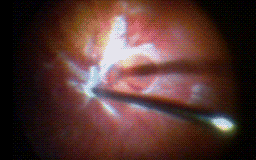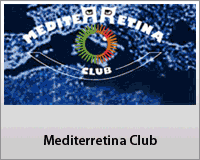|
 |
- Home
- Curriculum
- The Centre
- Contact
- Patients Area
- Congress
- Video Gallery
- Photo Gallery
- Prizes
- Founder
Forlini Cesare Links: Medical Journals | Eyetube | Youtube | Links
|
 |
Forlini Cesare Links: Medical Journals | Eyetube | Youtube | Links
New tests to uncover genetic predisposition to a macular degeneration linked to age have been perfected. With a simple sample of organic material (saliva) it is possible to quantify the risks of developing this illness or in serious affirmative cases, to foresee the seriousness of the pathology.
All this allows the doctor to diagnose and begin a preventive therapy very quickly based on the use of antioxidant molecules that have been shown to be more effective during the initial phases of serious pathologies.
A new slow working drug called ILUVIEN, available since June 2012 is designed to treat diabetic induced macular edema. The drug allows a slow release that injected directly into the eye frees a natural cortisone substance in the ocular cavity that is useful in reducing the micro inflammations and other factors that increase vascular endothelium (VEGF), both being involved in the damage to the microcirculation that causes damage to the diabetic retina. With protracted use the drug has been seen to be effective in improving sight acuity for at least two years after the intraocular injection. Data from the experimental period have shown some possible undesirable side effects such as cataracts and ocular hypertension.
Ozurdex is another slow releasing substance , injected into the vitreal cavity, it is used to treat macular edema after central and/or branch retinal vein occlusion (BRVO). The active principle consists of a steroid (dexamethasone) that, like all cortisone based drugs, combines powerful anti-inflammatory properties with anti-edema characteristics that inhibit vascular expansion (VEGF). Before being approved by the American Food and Drug Administration (FDA) Ozurdex was experimented on hundreds of patients with positive results both terms of sight acuity and reduction of post thrombotic macular edema. Additional studies are underway to ascertain use of this drug in other pathologies such as diabetic retinopathy and other age related macular degenerative conditions.
In the field of posterior segment surgery, that is interventions on the structures behind the crystalline, significant improvements have been made thanks to the introduction of low caliber surgical instruments.
e vitreous is one of the most important connecting bodies in the human body: its a semi solid,
gelatin like transparent structure that contains a high percentage of water and protein, it occupies the internal part of the ocular bulb and is in direct contact with the crystalline and later with the retina.
A vitrectomy, that is surgical removal of the vitreous, is the standard procedure in vitreo-retinal pathologies.
To access inside the ocular structure, up until recently the surgeon used instruments with minimum calibre of 20 gauge (0.9mm), thus requiring a opening the conjunctiva by at least this diameter. Today 23 gauge (0.72mm) and even 25 gauge (0.5mm) are available thus permitting transconjunctival access. This minimally invasive technique results in less painful post operative recovery and more comfort for the patient.
Indicated pathologies where this minimally invasive technique can be implemented are: pediatric ocular surgery, epiretinal membranes, macular holes, tractional diabetic macular edema, serious vitreous floaters, macular tractions, secondary turbidity of the vitreous.
Up until recently refractive surgery was not an option for patients suffering from elevated levels of myopia or hypermetropia. The entity of correction required was not safely attainable with surgical techniques that required cornea remodelling. Notwithstanding this, patients being surgically treated for cataracts were cured successfully by implanting small artificial lenses (called Intraocular Lenses), hence the term IOL.
The surgical procedure for cataracts in fact required the removal of the natural lens (crystalline) and the substitution with the IOL, this restored the function of focusing of the natural lens and cured the pre-existing conditions of myopia or hypermetropia. Using the same approach a specific type of IOL called Phakic intraocular lens (or PIOL), was developed for patients that do not suffer from cataracts but have elevated refractive deficiencies outside of the scope of regular excimer laser treatment. To preserve the ability to focus of the natural lens, necessary for close up sight, the natural lens is not removed from the eye. The phakic lens, sometimes referred to as the “Internal Contact Lens” or (ICL) is surgically grafted to the eye, in front of the crystalline or natural lens.
akic lenses are used throughout the world in many different forms of implants. As the procedure requires the surgeon to enter inside the eye, something that is not required with PRK and LASIK techniques, the risk for complications is higher. One of the most innovative products in the IOL line is a new lens brought out by Alcon called CACHET. This lens allows defects from -6 to -16.5 diopters to be treated and, thanks to an innovative design, allows the surgeon to reduce the number of complications such as corneal endothelial cell loss or ocular hypertension.
Nationally and internationally renowned for his scientific passion and ability to create innovative surgical solutions on the technological forefront, Dr. Cesare Forlini is today one of the most famous ophthalmic surgeons in the world. This web site presents on one side, content related primarily to Dr. Forlini’s scientific/clinical professional path including a detailed professional resume with scientific and clinical milestones achieved in his career. On the other side the content provided is informative providing information regarding his Private Practice (e.g. its location and contact details), where diagnostic examinations are performed. The information provided includes also a scientific section listing the instruments at the practices disposal, their uses and some of the most common procedures that take place. In addition to contact details and address there is also an urban map to assist the reader find the practice.
Dr. Cesare Forlini is the Director of the Operative Unit of Complex Ocular Surgery and Traumatology of the National Health care Unit of Ravenna.
He perfoms his diagnostic, consultancy and surgery on an institutional basis at the Operating Section of the Civil hospital at "Santa Maria delle Croci" in Ravenna
Private Practice (appointments and surgery) are performed in his private practice and in an “external specialized structure." (see section Private Practice")






